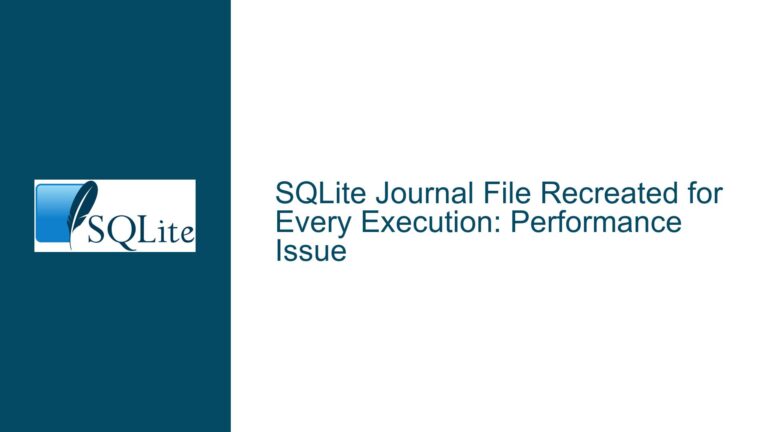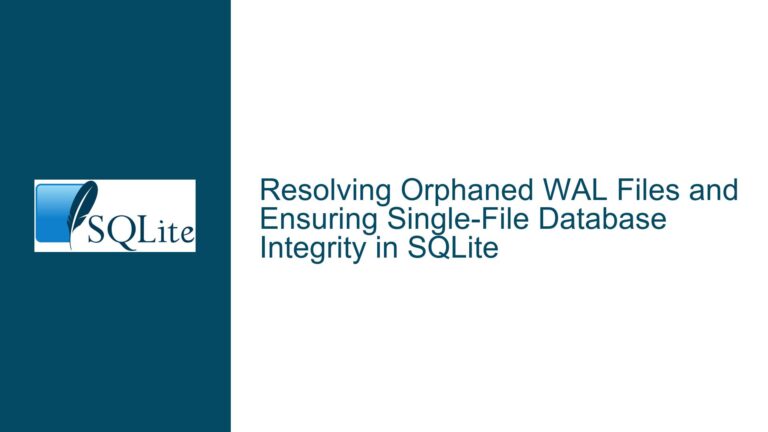Concurrency Challenges in SQLite In-Memory Databases
Parallel Read Performance in SQLite In-Memory Databases
SQLite is a lightweight, serverless database engine that is widely used for its simplicity and efficiency. However, when it comes to handling concurrent operations, especially in in-memory databases, SQLite presents unique challenges. The primary issue revolves around the inability to achieve true parallel read performance in an in-memory SQLite database, even when multiple threads are employed. This limitation stems from SQLite’s design and the inherent constraints of in-memory storage.
In a typical scenario, developers might attempt to leverage multiple threads to read from an in-memory SQLite database, expecting that each thread would operate independently and thus improve overall throughput. However, this expectation often leads to disappointment, as the threads do not proceed in parallel as anticipated. This behavior is observed regardless of whether the threads share a single connection or each thread maintains its own connection with shared cache enabled.
The core of the problem lies in SQLite’s architecture, which is not inherently designed to support true parallel operations, especially in an in-memory context. While SQLite does offer mechanisms like shared cache and write-ahead logging (WAL) to improve concurrency, these features are not sufficient to overcome the fundamental limitations when dealing with in-memory databases. The result is that even read-only workloads fail to achieve the desired parallel execution, leading to suboptimal performance.
Serialized Execution and Shared Cache Limitations
The serialized execution model of SQLite is a significant factor contributing to the lack of parallel read performance in in-memory databases. In SQLite, a connection is serially re-entrant, meaning that only one thread can execute within a connection at any given time. This design ensures data integrity and consistency but severely limits the potential for parallel execution. When multiple threads share the same connection, they are forced to execute sequentially, negating any benefits of multithreading.
Shared cache, another feature aimed at improving concurrency, also falls short in this context. Shared cache allows multiple connections to share a common cache, reducing memory usage and potentially improving performance. However, this feature was primarily designed for environments with extremely limited resources, such as embedded systems with minimal CPU and RAM. In more robust environments, shared cache can introduce additional overhead and complexity without delivering the expected performance gains.
Moreover, the shared cache mechanism relies on file locking primitives, which are not directly applicable to in-memory databases. In-memory databases lack the traditional file-based locking mechanisms, leading to more conservative locking protocols. This conservatism further restricts the ability of multiple threads to access the database concurrently, even for read-only operations. As a result, the shared cache does not provide the necessary infrastructure to support true parallel execution in in-memory SQLite databases.
Optimizing SQLite for Concurrent In-Memory Reads
To address the challenges of achieving parallel read performance in SQLite in-memory databases, several strategies can be employed. The first and most straightforward approach is to use a connection-per-thread model without shared cache. This model ensures that each thread has its own dedicated connection, allowing for independent execution. While this approach does not guarantee linear performance scaling, it can provide marginal improvements by reducing contention and overhead associated with shared cache.
Another important consideration is the use of the Write-Ahead Logging (WAL) journal mode. WAL mode can significantly improve concurrency by allowing readers to operate without blocking writers and vice versa. However, it is essential to note that WAL mode is primarily designed for file-based databases and may not offer the same benefits in an in-memory context. Nevertheless, enabling WAL mode can still provide some concurrency improvements, especially in scenarios where the database is stored on a RAM disk or a similar memory-mapped filesystem.
Disabling memory statistics collection using the SQLITE_CONFIG_MEMSTATUS configuration option can also help improve performance. Memory statistics collection introduces additional overhead, which can be particularly detrimental in high-concurrency environments. By disabling this feature, the database can allocate more resources to actual query execution, potentially improving throughput.
For environments where performance is critical, consider using a RAM disk or a memory-mapped filesystem to store the database. This approach combines the benefits of in-memory storage with the concurrency mechanisms of file-based databases. By placing the database on a RAM disk, you can leverage SQLite’s file locking primitives and WAL mode to achieve better concurrency and performance. This setup allows multiple threads to access the database more efficiently, as the underlying filesystem can handle the necessary locking and synchronization.
In conclusion, while SQLite in-memory databases present challenges for achieving parallel read performance, careful configuration and optimization can help mitigate these issues. By using a connection-per-thread model, enabling WAL mode, disabling memory statistics collection, and leveraging RAM disks, developers can improve the concurrency and performance of their SQLite in-memory databases. However, it is important to manage expectations, as true parallel execution may still be limited by SQLite’s inherent design constraints.






